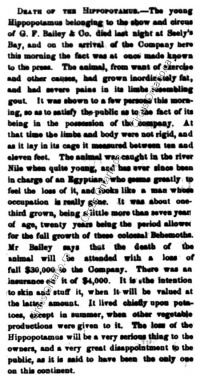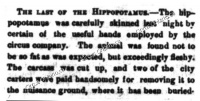Additions have been made since the initial shutdown and the site now covers 1830 -> 1880. It will not proceed further until more playdates data has been filled in for the current range and maps upgraded. Get involved.
A new membership programme is being incorporated. Contributors are those who wish to donate data, don't want to be too involved, but would like to follow certain parts of the system and be advised of updates, etc. Researchers are those who want to be more involved and have access to all the internal benefits of the system. This level requires weekly upkeep.
Public viewers will still have complete access to all regular data. Members just get to see the background processes and on-going research.
Bailey (G F) & Co's Metropolitan Quadruple Combination 1867/Death of the Hippo
A Rare Event: Hippopotamus Dies in Ontario
On Jun 18th, 1867, while being moved to the next play date of the G F Bailey & Co.'s Metropolitan Quadruple Combination Circus,
the primary attraction of the troupe died in Seeley's Bay, Ontario.
(The New York Clipper reported the death occurred at Coleman's Tavern, 21 miles east of Kingston.)
The troupe continued the journey and opened in Kingston on time with their parade through the city shortly after 9:00am.
They brought the body of the hippo with them as it was estimated to still be worth $4000, a stated loss to the company of $30,000.
It was shown to the city press that morning to prove the fact. Said to be about seven years old and captured on the Nile when quite young,
the intent was to have the animal stuffed.
The hippo was skinned that evening by circus people, the carcass cut up and given to carters for disposal in the local Kingston dump;
where it was then unceremoniously buried.
The initial diagnosis was that the hippo had gotten very fat from a lack of exercise and diet of potatoes, and had been suffering from
something akin to gout for some time. When the animal was skinned, it was noted there was little fat and actually a lot of flesh instead.
No additional comments were given about an alternative cause of death.
The Clipper reported that Allah, the hippo's keeper, was to leave for Europe in search of a replacement hippo.
Their "backup" hippo had earlier perished in a fire in London.
The search for a new hippo was obviously not very successful as it's reported in the Clipper, that when Bailey's troupe opened in Detroit
the following season, the hippo was "so preserved as to appear life-like" & that a rhino was expected to join the tour for the inaugural play date.
The hippo that died may well have first been shown in 1865 as the report seems well suited to be about a baby hippo. (it definitely was not Quick's first}
Clipper [1] The hippopotamus is not such a huge monster as the bills would lead us to imagine it to be; in some respects it resembles a mammoth hog, although its mouth is vastly more capacious than that of the biggest porker we ever say. Ali, the Egyptian, who caught the clumsy, lazy looking beast, is about as dirty and lazy looking as the animal he drives
Note: It may be thought that death occurred as a result of poor care and/or inexperience in dealing with the particular concerns of a hippopotamus.
In fact, Bailey and his partners (Quick, in particular) had a great deal of experience with the hippo and it was a tremendous draw for the circus, so care would have been of the utmost concern.
Clipper [2] Mr. Gerard C. Quick, of Zoological fame, has shipped for this city a living hippopotamus of enormous dimensions... It is one of those recently captured on the river Ganges.
Clipper [3] G. Bailey's circus was at Montreal on the 20th; where, also, Quick was showing the hippopotamus
Clipper also reported Bailey had hippo in at least the years 1863, 1864, 1865, and 1866
Associated News Reports

